Class 12-science NCERT Solutions Biology Chapter 6 - Evolution
Evolution Exercise 126
Solution 1
- Joshua Lederberg and Esther Lederberg showed the genetic basis of adaptations in bacteria by culturing bacterial cells by their plating experiment.
- Lederberg took an agar plate and inoculated bacteria on it by taking a dilute suspension. He thus obtained the master plate of bacteria.
- He then took a sterile velvet disc mounted on a wooden block and gently pressed it on the master plate. Many bacteria stuck to it.
- He then pressed this velvet on new agar plates and obtained new master plates inoculated with bacteria which were exact replicas of the original master plate.
- He again took the impression from the master plate and applied it on another agar plate containing antibiotic penicillin.
- He observed that few colonies were able to grow on the agar plate and were said to be penicillin-resistant, while the others that did not grow were said to be penicillin-sensitive.
- According to Darwin’s view, there were a few bacteria carrying mutant genes in the original suspension of bacteria which had the ability to survive the action of penicillin and form colonies. These mutations had arisen by chance and had not been induced by penicillin.
- This reveals the phenomenon of natural selection where the mutant variety of bacteria had the selective advantage to overcome the effect of penicillin rather than the non-mutant type.
Solution 2
Few new fossil discoveries or controversies about evolution found from newspapers and popular science articles:
- Large-feathered dromaeosaur: A recent fossil study described a large, feathered dinosaur Zhenyuanlong. It had asymmetrical feathers probably as an adaptation for flight but was likely too large to fly. The discovery of this dinosaur illustrates that feathers probably evolved for reasons of sexual display or insulation rather than purely for powered flight.
- Monster scorpion: A 1.7-metre long 460 million-year-old sea scorpion was discovered in the remains of an ancient ocean in Iowa. It had a strangely shaped head and paddle-like appendages. It is the oldest sea scorpion ever discovered.
- 540 million-year-old brain: It is a common prenotion that brain tissue, like most soft tissues, does not fossilise. Recent studies have described a fossilised shrimp-like creature which had preserved brain tissue. This amazing discovery of a brain reveals clues about the evolution of the shape of the central nervous system, which is typically impossible to trace in the fossil record.
- Challenge to human evolution: A 14,000-year-old thigh bone belonging to a mysterious human species was discovered in southwest China. Analysis of the remains suggests a separate group of prehistoric ancient humans different from the Neanderthals or Homo sapiens. This ancient group lived until as recently as the last Ice Age, which ended about 12,000 years ago.
Solution 3
A species is a group of similar individuals differing from the members of other species. They interbred freely, produce fertile offspring, share a gene pool and are relatively stable. The species is the smallest unit of classification.
Solution 4
During human evolution, the ancestors of humans went through several changes with respect to brain size, skeletal features and dietary preferences as listed in the table below:
|
Ancestors in human evolution |
Brain size |
Teeth |
Skeletal features |
Dietary preferences |
|
Dryopithecus
|
Large brain (size unknown) |
Large canines and incisors, square molars |
|
Soft fruits and leaves |
|
Ramapithecus
|
Small brain (size unknown) |
Small canines, flattened molars |
|
Hard nuts and seeds |
|
Australopithecus afarensis
|
500 cm3 |
Small canines and incisors |
|
Mostly fruits and leaves rather than seeds and other hard plant material |
|
Australopithecus africanus |
350–450 cm3 |
Small canines |
|
Essentially fruits but hunted with stones |
|
Homo habilis |
650–800 cm3 |
Small canines |
|
Probably did not eat meat |
|
Homo erectus |
800–1,200 cm3 |
Small canines |
|
Probably ate meat |
|
Homo neanderthalensis |
1,400 cm3 |
Heavier than modern teeth, wisdom teeth |
|
Cannibals |
|
Homo sapiens fossils |
1650 cm3 |
Teeth closer together, wisdom teeth |
|
Ate both plants and animals |
|
Homo sapiens sapiens |
1,500 cm3 |
Strong jaws with teeth closer together, wisdom teeth |
|
Ate both plants and animals |
Solution 5
Yes, animals such as orangutans, chimpanzees, gorillas, elephants and rhesus macaques are self-conscious. They have well-developed facial muscles for expressing facial gestures and communicating with animals bearing similar self-consciousness.
Solution 6
|
Modern Day |
Ancient Fossil |
|
Modern horse (Equus) |
Eohippus (=Hydracotherium) - Dawn horse - The first fossil found in the evolution of horse. |
|
Camel (Camelus) |
Protylopus - The first ancestor of modern camel. |
|
Modern Elephant (Elephas) |
Moeritherium - The ancestor of modern elephant. |
|
Man (Homo sapiens) |
Ramapithecus - The oldest of man's ancestors. |
|
Vertebrates |
Seymouria - The missing link between amphibians and reptiles. |
|
Reptiles |
Cyanognathus - The missing link between reptiles and mammals. |
|
Birds |
Archaeopteryx - The missing link between reptiles and birds. |
|
Mammals |
Cyanognathus - The missing link between reptiles and mammals. |
|
Apes and mammals |
Dryopithecus - The common ancestor of apes and mammals. |
|
Gibbon |
Propliopithecus – The ancestor of gibbons. |
|
Frogs, toads and salamanders |
Some stem amphibians called Labyrinthodontia (e.g. Eryops) gave rise to modern amphibians such as frogs, toads and salamanders. |
|
Nautilus |
Gyroceros – The ancestor of the mollusc family. |
|
Octopus |
Belemnite – The extinct fossil of cephalopods. |
Solution 7
With the help of your books and the Internet, practise drawing diagrams of various plants and animals you have come across. Some diagrams of different plants and animals have been illustrated below for your reference.
Diagrams of animals:
i.Peripatus - Walking worm

ii.Protopterus - African lung fish
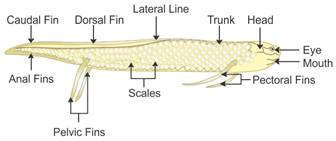
iii.Ornithorhynchus - Duck-billed platypus
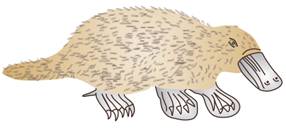
Diagrams of plants:
i.Stem tendrils of Passiflora
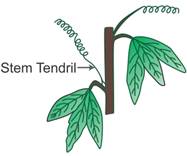
ii.Leaf tendrils of Pisum sativum
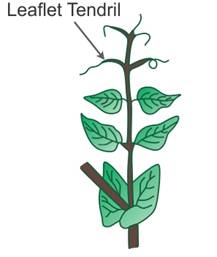
iii.Leaf spine of barberry
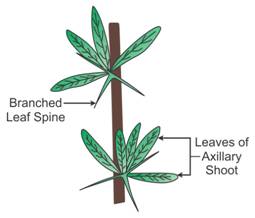
Solution 8
Adaptive radiation is a process of divergent evolution in which members of the same ancestral species of a large taxonomic group are evolved along different lines in different habitats of the same geographical area.
Darwin's finches of the Galápagos Islands exhibiting a variety of beaks are an example of adaptive radiation. Darwin reported that finches found on different islands of the Galápagos Islands with varied environmental conditions differed with respect to bill size and shape due to different feeding habits. However, they were closely related to one another and had evolved from a common ancestral seed-eating ground finch living in a particular geographical area of the South American mainland. Later, these finches radiated to different geographical areas and adapted differently in their feeding habits, developing different kinds of beaks.
Solution 9
No, we cannot call human evolution as adaptive radiation. In human evolution, brain size, skeletal structure, dietary preference and social and cultural evolution occurred, while in adaptive radiation, the origin, basic structure and development of the organs remain same, only morphological changes occur.
Solution 10
The evolutionary history of horse has been traced from the fossils discovered from the tertiary rocks in North America. The ancestry of horse is tabulated below:
|
Scientific name |
Common name |
Epoch |
Age (in million years) |
Height (in cm) |
Fingers |
Toes |
Molars |
|
Eohippus |
Dawn horse |
Eocene |
60 |
30 |
4 (1 splint finger) |
3 (2 splint toes) |
Short crowned |
|
Mesohippus |
Intermediate horse |
Oligocene |
40 |
60 (Pony size) |
3 (1 splint finger) |
3 (1 splint toe) |
Short crowned |
|
Merychippus |
Ruminating horse |
Miocene |
25 |
100 (Ass size) |
3 (1 splint finger) |
3 (1 splint toe) |
Long crowned |
|
Pliohippus |
Pliocene horse |
Pliocene |
10 |
108 |
Only 3rd finger (2nd & 4th digits as splint bones) |
Only 3rd toe (2nd & 4th digits as splint bones) |
Long crowned |
|
Equus |
Modern horse |
Pleistocene |
0.5 |
150 |
Only 3rd finger (2nd & 4th digits as splint bones) |
Only 3rd toe (2nd & 4th digits as splint bones) |
Long crowned |

